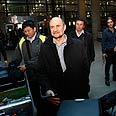
IAEA: Secrecy raises fears of more Iran atom sites
International Atomic Energy Agency report claims it has evidence construction of nuclear site in Qom began in 2002, not 2007 as Iran stated. According to report, Iran failed to show plant was for civilian purposes. Tehran rep: IAEA reports repetitive
Iran's belated revelation of a new uranium enrichment site raises concern about possible further secret nuclear sites, according to a UN nuclear watchdog report obtained by Reuters on Monday.
It said Iran had told the International Atomic Energy Agency that it had begun building the bunkered site near Qom in 2007 - but the IAEA had evidence the project had begun in 2002, paused in 2004 and resumed in 2006. Iran revealed the site's existence in September.
The report said Iran had provided full access for IAEA inspectors on their first visit to the Qom site three weeks ago, but had yet to provide full, credible answers to verify that the plant was only for civilian purposes.
"The agency has indicated (to Iran) that its declaration of the new facility reduces the level of confidence in the absence of other nuclear facilities under construction and gives rise to questions about whether there were any other nuclear facilities not declared to the agency," the report said.
Iran's failure to inform the agency of its decision to build or authorize construction of a sensitive nuclear facility as soon as the decision was made was "inconsistent" with its transparency obligations to the UN watchdog, it said.
"Moreover, Iran's delay in submitting such information to the agency does not contribute to the building of confidence," it said, adding that Iran had more questions to resolve about the site's chronology and purpose.
Iran told the IAEA the Qom site was conceived as a fallback to preserve its declared civilian enrichment program if the far larger Natanz complex was bombed by enemies such as Israel.
Western diplomats and nuclear experts say the Qom site's planned capacity - 3,000 centrifuges - makes little sense as a stand-alone civilian enrichment centre since it would be too small to fuel a nuclear power station around the clock.
It could, however, yield fissile material for one or two atom bombs per year.
'Qom at advanced state'
The IAEA report said inspectors found the Qom site in "an advanced state" of construction, but without centrifuges or nuclear materials. It said Iran had told the agency it would be started up in 2011.
IAEA inspectors also found Iran this month was enriching uranium with 650 fewer centrifuges - 3,936 - at its main Natanz nuclear complex than in August, although it had slightly raised the total number of installed machines, to 8,692.
Western diplomats and analysts said the hold-down in expanding the scope of its enrichment - technology that can yield fuel for power plants or for atom bombs - was probably caused by technical problems.
Tehran's envoy to the IAEA, Ali Asghar Soltanieh, said that Iran would continue uranium enrichment and dismissed the latest report as "repetitive".
"Iran will continue to exercise its right to peaceful use of nuclear energy, including enrichment," Soltanieh told Fars news agency on Monday.
Soltanieh called on the IAEA's member states to "put an end to this repetitive and tedious path, as the reports by the (atomic) agency chief have nothing new."
Reuters and AFP contributed to the report










